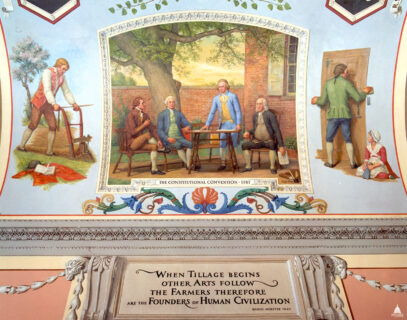
Establishing the Electoral College and the Presidency
Major Themes at the Constitutional Convention
What were the delegates’ initial thoughts regarding an Executive?
The Virginia Plan, introduced by Edmund Randolph on May 29, called for the creation of a National Executive elected by the Congress. On the initial consideration of the proposal, the delegates on June 1, June 2, and June 4 agreed on a single executive who would serve a seven-year term and be ineligible for re-election. Some delegates wanted to:
- Settle the issue of re-eligibility first, others wanted to;
- Fix the length of term before proceeding further, still other delegates wanted to;
- Discuss how the executive would be elected before considering anything else, and still other delegates thought;
- That the powers of the President should be the primary question to be settled.
How did they propose to elect an Executive?
On the first reading, and every time thereafter, the convention agreed to provide the chief executive with a veto subject to Congressional override. (See “Debating the Limits of the Judiciary”) The biggest issue was how to elect the President. On June 9, the delegates defeated a motion to have the President elected by state executives. On June 18, Hamilton surprised the delegates with a proposal for a President for life.
The delegates revisited the four main issues—without settling any one once and for all—involved in the construction of the executive on July 17, 18, 19, 20, 24, and 26.
- July 17: the delegates agreed to a single executive elected by the legislature, and to be re-elected rather than serve during good behaviour.
- July 18 and 19: the delegates revisited the issue of whether the President should be re-eligible and embraced the idea that perhaps the president should be chosen by electors chosen by state legislatures.
- July 20: a proposal permitting the impeachment of the president was approved.
- July 24: the delegates returned to the earlier position: the President should be elected by the national legislature.
- July 26: the delegates approved a seven-year term for the President. But he would be ineligible for re-election!
What did the Brearly Committee recommend?
The Committee of Detail Report of August 6 summarized where the delegates stood. On August 24, the delegates turned to the Presidential article and defeated four different modes of electing the President. In the end, the Convention selected members of the Brearly Committee whose objective was to settle outstanding issues. The chief of these was the Presidential clause. On September 4, the Brearly Committee recommended that the Convention support the Electoral College method of choosing a president. On September 6 and 7, the delegates agreed to a four-year renewable term for the President and that he be a natural born citizen. On September 8, the delegates settled the treaty-making power and agreed on the impeachment of the President for “high crimes and misdemeanours.” Finally, on September 15, the delegates added “the inferior officers clause.”
To summarize, the Brearly Committee, composed of Gilman, King, Sherman, Brearly, G. Morris, Dickinson, Carroll, Madison, Williamson, Butler, and Baldwin—a veritable cross-section of the delegates—proposed the adoption of an Electoral College in which both the people and the States would be represented in the election of the President. This resolution of the most durable of issues at the convention—the difficult question of Presidential election—clearly meant that the “partly national, partly federal” model had become the deliberate sense of the convention. Like Congressional representation, the process of electing the president would reflect the sense of the community that the union was partly federal and partly national.
